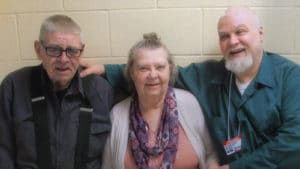"Don't let Netflix tell you what to think". The Netflix documentary Making a Murderer caused a huge stir in the United States and the rest of the world in 2016. Society was divided into two camps: those who believed Steven Avery was guilty and those who believed he was once again innocent in prison. Twin camps. Just like a few weeks ago in the case surrounding the nomination of Brett Kavenaugh as a Supreme Court judge. In Avery's case, this resulted in petitions and demonstrations, as well as death threats against the sheriff and prosecutor, among others. Now Netflix is releasing a second season on 19 October; Making a Murderer: Part Two. I got the chance to preview some episodes of the new season.
Has Steven Avery once again been framed by police and the justice system? The makers of Making a Murderer do all they can to convince the viewer of this, presenting a believable story. Whereas one is normally innocent until proven guilty, in Avery's case it seems to be the other way around.
Power of the media
For Making a Murderer media have become a good leverage point for the teams trying to get both Steven Avery and Brendan Dassey released. Moreover, they expose the mistakes of the police and judiciary; the ones who decide on someone's freedom, and, in extreme cases, life and death. For Kathleen Zellner, Steven Avery's lawyer, the favourite medium to draw the public's attention to the mistakes of the police and judiciary is this: Twitter.

The fight against the judiciary
The first episodes of second season pay more attention Brendan Dassey; as a son and brother, as a person. We also get an insight into the situation surrounding the coerced confession and how his current-'post-conviction' lawyers are fighting to overturn Brendan's conviction. After going through several discs in the US legal system, there is light visible at the end of the tunnel. Federal Judge Duffin admits that the conviction based on the confession is not valid. However, prosecutor Brad Schimel is filing an appeal against the decision on behalf of the state. Of course, because the decision has far-reaching implications for the case and conviction of Steven Avery, whose case is based on Brendan's confession. Once innocent in jail because of corruption is a blameworthy thing, but a second time is obviously disastrous.

There is no business like show business
As already seen in the first part, the media have had a huge impact on the perception and course of Avery and Dassey's lives. The second season also highlights this element. Not only the judicial part, but also the personal aspect. Where there are cameras, there are also people eager for their 'fifteen minutes of fame'. In a sensational case like this, it happens that individuals come forward who claim to have witnessed something or make confessions that are not true.

In addition, you have (especially) women who Making a Murderer have been following and are interested in a relationship with Brendan or Steven. The perfect subject for (TV) psychiatrist Dr Phil. Brendan's fiancée, Sandra Greenman, dumped him for religious reasons when she was a guest on Dr Phil. Season two shows that they are still very close. His relationship and engagement to Lynn Hartman was initially kept secret to avoid (online) threats. The irony: Lynn has been married to a police officer. During Dr Phil's show, she was in love and convinced of his innocence. However, an update a year later claims the opposite. She received, according to her, undisguised, explicitly threatening letters from Avery. He claims to have dumped her because she is a 'gold digger'. That she had entered into a relationship with him for publicity and money. All this, of course, adds to the perception of guilt or innocence.

What is the truth
In the first episode, a person involved makes the comment "No faith in the system" and this seems to be an accurate statement. This is confirmed when Kathleen Zellner says during her examination of the evidence, "They are going to regret the day they planted that evidence." As a viewer, you get sucked into the story; the deconstruction of the case and evidence provided by various experts evoke a primary sense of outrage and injustice. What is the truth? The final answer to that question will probably be some time in the future. If it ever comes. Until then, Netflix and the other media do assist the public in forming a certain picture.

From 19 October, the 10 episodes of the second season of Making a Murderer will be available to watch on Netflix.
